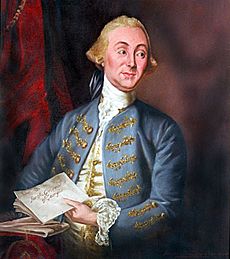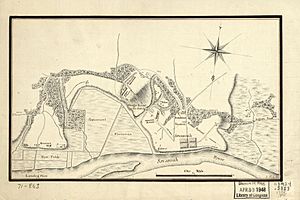Capture of Savannah facts for kids
Quick facts for kids Battle of Savannah |
|||||||
|---|---|---|---|---|---|---|---|
| Part of the American Revolutionary War | |||||||
 Lieutenant Colonel Archibald Campbell (portrait by George Romney, c. 1792) |
|||||||
|
|||||||
| Belligerents | |||||||
| Commanders and leaders | |||||||
| Strength | |||||||
| 850 infantry and militia 4 guns |
3,500 infantry and militia unknown artillery |
||||||
| Casualties and losses | |||||||
| 83 killed 11 wounded 453 captured |
7 killed 17 wounded |
||||||
The Battle of Savannah was an important fight during the American Revolutionary War. It happened on December 29, 1778, in Savannah, Georgia. American soldiers and local fighters, called militia, were defending the city. They faced a British army led by Lieutenant Colonel Archibald Campbell.
The British won this battle and took control of Savannah. This victory was the first step in Britain's plan to regain control of the southern colonies. They hoped to find many Loyalists (people loyal to the British King) in the South.
General Sir Henry Clinton, the top British commander in North America, sent Campbell's force from New York City. Their goal was to capture Savannah and bring Georgia back under British rule. Another British force, led by Brigadier General Augustine Prevost, was marching from Saint Augustine.
Campbell landed near Savannah on December 23. He saw that the American defenses were weak. So, he decided to attack right away, without waiting for Prevost. With help from a local guide, Campbell's troops secretly went around the American army. They captured many of Major General Robert Howe's soldiers. The rest of the American troops had to retreat into South Carolina.
After this victory, Campbell and Prevost also captured Sunbury and briefly Augusta. However, Campbell soon left Augusta. He felt there wasn't enough support from Loyalists or Native Americans. Also, American forces in South Carolina were a threat. The British held Savannah until near the end of the war. They even fought off a combined French and American attack in 1779.
Contents
Why the Battle Happened
In 1778, the British army lost a major battle at Saratoga. This defeat led France to join the war as an ally of the Americans. After this, Lord George Germain, a British government official, wrote to General Sir Henry Clinton. He said that taking back the southern colonies was very important to King George III. Germain suggested that Clinton should leave Philadelphia and focus on capturing Georgia and the Carolinas.
British Plans for the South
In the summer of 1778, Clinton moved his troops from Philadelphia back to New York. By November, he turned his attention to the South. He put together about 3,000 soldiers in New York. He also sent orders to Saint Augustine, Florida. There, Brigadier General Augustine Prevost was to gather all available men. A British agent, John Stuart, was to get Creek and Cherokee warriors to help. The main British plan was to capture Savannah, the capital of Georgia.
Lieutenant Colonel Archibald Campbell was put in charge of the troops from New York. His force included:
- Two battalions of the 71st Regiment of Foot (Scottish soldiers).
- Two Hessian regiments (German soldiers hired by the British).
- Four Loyalist units (Americans who fought for the British).
Campbell's ships left New York on November 26. They arrived near the mouth of the Savannah River on December 23.
American Defenses in Georgia
Georgia was defended by two groups of soldiers. The Continental Army units were led by Major General Robert Howe. He was in charge of defending the whole South. The state's local fighters, the militia, were led by Georgia Governor John Houstoun.
Howe and the Georgia leaders had argued before about military plans. Their past efforts against the British in Florida had failed. Because of this, the Continental Congress decided in September 1778 to replace Howe. They chose Major General Benjamin Lincoln instead. However, Lincoln had not yet arrived when Howe learned that British troops were coming to Georgia.
In November 1778, British raids into Georgia became more serious. Even so, Governor Houstoun would not let Howe control the Georgia Militia. Howe began marching south from Charleston, South Carolina with 550 Continental Army troops. He reached Savannah in late November. He learned that Campbell had sailed from New York on December 6. On December 23, British ships were seen near Tybee Island. The next day, Governor Houstoun finally gave Howe 100 Georgia militia.
A meeting of military leaders decided to defend Savannah strongly. They knew they would likely be outnumbered. But they hoped to hold out until Lincoln's troops arrived. Howe had to keep most of his army ready. He waited until the British actually landed before moving his main forces.
Who Fought in the Battle
American Forces
- Commander: Major General Robert Howe
- 4th Georgia Regiment
- 500-550 Georgia and South Carolina Militia, led by Brigadier General Isaac Huger
British Forces
- Commander: Lieutenant Colonel Sir Archibald Campbell
- 71st Regiment of Foot (Highland Scots)
- 4 Battalions of German Mercenaries (Hessians)
- North Carolina Royalist Battalion
- South Carolina Royalist Battalion
- New York Volunteers
- Artillery (cannons), led by Lieutenant Ralph Wilson, from the Royal Artillery
The Battle Begins
Campbell chose to land his troops at Girardeau's Plantation. This spot was about 2 miles (3 km) below Savannah. When Howe heard the landing started on December 29, he sent some Continental soldiers. They went to hold the high ground above the landing site.
Campbell knew he needed to control these bluffs to land his army. He sent two companies of the 71st Regiment to take them. The American soldiers fired from about 100 yards (91 m) away. But the British did not fire back. Instead, they quickly charged with bayonets (knives on the end of rifles). This stopped the Americans from getting a second shot. The American soldiers retreated. They had killed four British and wounded five, without losing any of their own. By noon, Campbell had landed his army and slowly moved towards the city.
Howe held a meeting that morning and picked a place to fight. About half a mile (0.7 km) south of the city, he set up a V-shaped defense line. Swamps protected both ends of the line. On the left, Howe placed Georgia Continental soldiers and militia. On the right, he put South Carolina Continental soldiers and militia. Four cannons supported the line. Light infantry (fast-moving soldiers) guarded the sides. Most of Howe's troops had not fought much in the war.
When Campbell's lead troops saw Howe's line around 2:00 pm, the main British force stopped. Campbell went to see the American defenses. He thought Howe's position was strong. But a local enslaved person told him about a secret path through the swamp on Howe's right side. Campbell ordered Sir James Baird to take 350 light infantry and 250 New York Loyalists. They followed the enslaved person through the swamp. Meanwhile, Campbell arranged his main troops to make it look like he would attack Howe's left. One of his officers climbed a tree to watch Baird's progress.
The enslaved person was right. The path came out near the American barracks, which were unguarded. The American soldiers did not know they were being surrounded. When Baird's troops were in position, the man in the tree waved his hat. Campbell then ordered his regular troops to charge.
The first sounds of battle Howe heard were gunshots from the barracks. Soon after, cannons fired, and British and German troops charged from the front. Howe ordered an immediate retreat. But it quickly turned into a confused escape. His inexperienced troops barely fired back. Some threw down their weapons and tried to run through the swamp. Campbell later said, "It was scarcely possible to come up with them, their retreat was rapid beyond Conception." The British light infantry behind the American lines cut off the road to Augusta. This was the only good escape route. Many American troops were forced to run into the city.
The Georgia soldiers on the right tried to find a safe way across Musgrove Creek. But there was no easy crossing. Many of these soldiers were captured. Soldiers who did not surrender right away were sometimes stabbed with bayonets. Colonel Huger managed to form a small group to protect the escaping Continental soldiers. Some of Howe's men escaped north before the British surrounded the city. Others tried to swim across Yamacraw Creek. An unknown number drowned trying to cross.
What Happened After the Battle
Campbell took control of Savannah. His forces lost only seven killed and seventeen wounded. This included the four killed and five wounded during the first small fights. Campbell captured 453 American soldiers. At least 83 American soldiers were killed and 11 wounded. About 30 American soldiers are thought to have drowned during the retreat. When Howe's remaining troops reached Purrysburg, South Carolina, he had only 342 men left. This was less than half of his original army.
Howe was blamed a lot for this disaster. Some, like William Moultrie, said he should have fought harder at the landing site. Or he should have retreated without fighting to keep his army together. Howe was later cleared of blame in a military trial. But the trial did say he should have made a stronger stand at the bluffs or against the landing.

General Prevost arrived from East Florida in mid-January. Soon after, he sent Campbell with 1,000 men to take Augusta. Campbell captured the town with little resistance. But by then, General Lincoln had started gathering support in South Carolina to fight the British. Campbell left Augusta on February 14. On the same day, a Loyalist force heading to meet him was defeated at the Battle of Kettle Creek. Even though American forces following the British were defeated at the Battle of Brier Creek on March 3, the Georgia countryside stayed in American hands.
Campbell wrote that he would be "the first British officer to [rend] a star and stripe from the flag of Congress." Savannah became a base for British raids along the coast. These raids targeted areas from Charleston, South Carolina to the Florida coast. In the fall of 1779, a combined French and American attack to take back Savannah failed. Many soldiers were lost. Control of Georgia was officially given back to its royal governor, James Wright, in July 1779. But the countryside would not be fully under British control until after the Siege of Charleston in 1780. American forces took back Augusta in 1781. But Savannah stayed in British hands until July 11, 1782.





